Liquid Powder
A new technology combines the advantages of powder coatings with the ease of application found with liquid coatings.
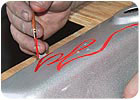
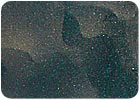 Powder coatings are known for being environmentally friendly, extremely durable and economical. Talk to anyone who uses powder coatings, and they’ll likely rave about the advantages of powder compared to liquid finishes - unless, of course, they’re trying to coat a substrate that requires certain special effects, has a complex surface or cannot handle high cure temperatures. In these cases, powder coaters often are forced to turn to solvent-based liquid coatings because many powder coatings simply aren’t up to the task.
Powder coatings are known for being environmentally friendly, extremely durable and economical. Talk to anyone who uses powder coatings, and they’ll likely rave about the advantages of powder compared to liquid finishes - unless, of course, they’re trying to coat a substrate that requires certain special effects, has a complex surface or cannot handle high cure temperatures. In these cases, powder coaters often are forced to turn to solvent-based liquid coatings because many powder coatings simply aren’t up to the task.
Tech Line Coatings, Inc., Murietta, CA, has sold high-temperature liquid coatings to a number of frustrated powder coaters over the last several years. According to President Leonard Warren, the problems encountered by these finishing professionals gave the R&D team at Tech Line an idea. Why not disperse powder coating powders in a water-based carrier so that they could be applied like a liquid coating while retaining all the benefits of a powder coating?
“We developed a water-based solution several years ago that we had been using with other products. We realized that this solution had the potential to become a carrier for powder, as well as allow us to add other ingredients to create unique special effects that can’t be achieved with powder coatings,” Warren says.
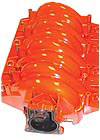
For example, a candy apple red can be achieved by blending the solution with a red dye and a clear powder, and applying it on top of an electrostatically applied sparkle silver basecoat. “Depending on the quantity of dye, you can change the color dramatically. It has a color and effect that you can’t get with just powder,” Warren says. “You can also apply different colors, color on color, fades and other special effects that you can’t achieve with just powder or liquid.”
The coating can be sprayed or airbrushed onto the substrate like a liquid paint. When the coating is used on complex surfaces, the “weight” of the water molecule allows the coating to be carried evenly and completely into areas that a powder cannot reach, or where an unsatisfactory buildup of powder occurs in the attempt to get the powder to reach these difficult areas.
As with a liquid paint, the coating must be dried prior to curing. The drying time varies, depending on the environmental conditions, but will be achieved faster in hot, dry weather and slower in humid weather. A climate-controlled drying room can be used to speed the drying process. The majority of the carrier solution (98%) evaporates during drying, and the remainder volatizes during curing, which is achieved at typical powder temperatures of 300 to 450ºF, depending on the particular powder used. According to Warren, the resulting finish has the same durability and performance characteristics as a conventional powder coating.
“Virtually all of the testing we’ve done internally - for adhesion, impact and flexibility - mirrors the performance of powder coatings,” he says. “Once you run the coating through the normal cure temperature for powder, you’re left with a powder coating crosslinked onto the part. Our carrier solution disappears during the cure process. The only issues that will create detrimental characteristics in the coating are incorrect surface prep or inadequate coating thickness, but these issues are the same as with conventional powder coatings.”
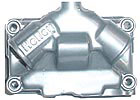
One other drawback is that the system isn’t cheap. A single gallon of the carrier solution, which equals about six quarts of finished product, depending on the load of the powder, currently costs about $100, and the coverage is the same as with conventional powder coatings. (The company also supplies a custom premixed version of the system, which it calls Powdr2O™, at a higher price.) However, Warren says that the system can reduce costs dramatically when used in place of many special effect wet paint materials.
For a number of applications, both the cost and minor technical challenges might be irrelevant when weighed against the benefits of using the new system.
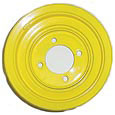 “For finishing shops that would like to get into powder coating, the carrier solution provides an inexpensive way to test the market viability of a powder coated product before investing in electrostatic equipment,” Warren says. “For companies that are already using electrostatic equipment, the solution can broaden their capabilities by allowing them to achieve uniform, high-quality finishes on complex substrates, and produce special effects that can’t be achieved with conventional powder coatings.”
“For finishing shops that would like to get into powder coating, the carrier solution provides an inexpensive way to test the market viability of a powder coated product before investing in electrostatic equipment,” Warren says. “For companies that are already using electrostatic equipment, the solution can broaden their capabilities by allowing them to achieve uniform, high-quality finishes on complex substrates, and produce special effects that can’t be achieved with conventional powder coatings.”
“We’re not trying to replace powder - we’re trying to expand it,” he adds.
For more information about the liquid powder technology, call 972.775.6130, e-mail info@techlinecoatings.com or visit www.techlinecoatings.com.

SIDEBAR:
One other technology pioneered by Tech Line is a clear topcoat designed for end-use applications under 500ºF, which the company markets under the tradename CilGen LTC™. According to Warren, the topcoat can be used with the Liqui-Powdr system to allow powder coatings to be used on low-temperature plastics, fiberglass and wood - substrates that can’t handle the high cure temperatures of conventional powder coatings. In addition to expanding the applications for powder, the topcoat offers the potential to apply powder coatings on products with mixed substrates, such as metal and plastic.
“Powder coating the metal components for those products and liquid coating the plastic would make color matching extremely difficult. With the clear topcoat, both the metal and plastic components can be powder coated for an exact color match,” Warren says.
A coating based on the carrier solution is applied to the substrate and placed in a cure oven at a temperature just high enough to melt the powder - typically 180ºF. After the melt phase is complete, the clear topcoat is applied by spraying or wiping and is allowed to air cure. The topcoat dries to the touch in one hour and cures to normal use in 24 hours. “After a full cure (which takes up to seven days), the coating is unaffected by most chemicals and is UV and corrosion resistant,” Warren says.
When asked whether the uncured powder coating beneath the topcoat would exhibit poor performance, Warren replies: “The topcoat fully protects the underlying coatings and substrate. Whether it’s used on top of a fully crosslinked powder, or on a powder melted at low temperatures, it creates a better finish than you can get with powder alone.”
Warren notes that one company tried to remove the coating to see how durable it was and found that the normal strippers had no effect. “It took 10 hours of polishing to remove the coating,” he says.

A liquid powder pinstripe is painted on a metal substrate - an effect that couldn’t be achieved with conventional powder coatings.

This special effect finish, called “Ghost Fire,” was achieved by airbrushing a liquid powder black with a liquid powder sparkle silver and then finishing with a liquid powder clear.
Tech Line Coatings, Inc., Murietta, CA, has sold high-temperature liquid coatings to a number of frustrated powder coaters over the last several years. According to President Leonard Warren, the problems encountered by these finishing professionals gave the R&D team at Tech Line an idea. Why not disperse powder coating powders in a water-based carrier so that they could be applied like a liquid coating while retaining all the benefits of a powder coating?
“We developed a water-based solution several years ago that we had been using with other products. We realized that this solution had the potential to become a carrier for powder, as well as allow us to add other ingredients to create unique special effects that can’t be achieved with powder coatings,” Warren says.

An intake manifold coated with the liquid powder system.
Converting Powder to Liquid
The carrier, which the company calls Liqui-Powdr™, is a variable viscosity solution. Prior to agitation, the solution has a gel-like consistency, but it becomes a sprayable liquid when it is agitated or stirred. According to Warren, this characteristic gives the product considerable formulation and application flexibility. Varying effects can be achieved either by applying multiple coats or by blending several colors and effects into a single mix. Special effects materials such as metallics, pearlescents and glitter can also be added to a clear powder and mixed into the solution.For example, a candy apple red can be achieved by blending the solution with a red dye and a clear powder, and applying it on top of an electrostatically applied sparkle silver basecoat. “Depending on the quantity of dye, you can change the color dramatically. It has a color and effect that you can’t get with just powder,” Warren says. “You can also apply different colors, color on color, fades and other special effects that you can’t achieve with just powder or liquid.”
The coating can be sprayed or airbrushed onto the substrate like a liquid paint. When the coating is used on complex surfaces, the “weight” of the water molecule allows the coating to be carried evenly and completely into areas that a powder cannot reach, or where an unsatisfactory buildup of powder occurs in the attempt to get the powder to reach these difficult areas.
As with a liquid paint, the coating must be dried prior to curing. The drying time varies, depending on the environmental conditions, but will be achieved faster in hot, dry weather and slower in humid weather. A climate-controlled drying room can be used to speed the drying process. The majority of the carrier solution (98%) evaporates during drying, and the remainder volatizes during curing, which is achieved at typical powder temperatures of 300 to 450ºF, depending on the particular powder used. According to Warren, the resulting finish has the same durability and performance characteristics as a conventional powder coating.
“Virtually all of the testing we’ve done internally - for adhesion, impact and flexibility - mirrors the performance of powder coatings,” he says. “Once you run the coating through the normal cure temperature for powder, you’re left with a powder coating crosslinked onto the part. Our carrier solution disappears during the cure process. The only issues that will create detrimental characteristics in the coating are incorrect surface prep or inadequate coating thickness, but these issues are the same as with conventional powder coatings.”

Various components coated with the new system. The carrier solution disappears during the cure process, leaving a powder coating crosslinked onto the part.
Expanding Capabilities
Warren admits that there is a learning curve to using the new system. Finishing professionals who aren’t familiar with powder will need to learn how to properly prepare the substrate surface and apply the right coating thickness (as with most powders, 3 to 5 mils provides the best quality). Likewise, finishers who are adept at powder will need to understand the methods and constraints of working with a liquid paint, including building in the right amount of drying time into the process.One other drawback is that the system isn’t cheap. A single gallon of the carrier solution, which equals about six quarts of finished product, depending on the load of the powder, currently costs about $100, and the coverage is the same as with conventional powder coatings. (The company also supplies a custom premixed version of the system, which it calls Powdr2O™, at a higher price.) However, Warren says that the system can reduce costs dramatically when used in place of many special effect wet paint materials.
For a number of applications, both the cost and minor technical challenges might be irrelevant when weighed against the benefits of using the new system.

Various components coated with the new system. The carrier solution disappears during the cure process, leaving a powder coating crosslinked onto the part.
“We’re not trying to replace powder - we’re trying to expand it,” he adds.
For more information about the liquid powder technology, call 972.775.6130, e-mail info@techlinecoatings.com or visit www.techlinecoatings.com.

A decorative wood piece coated with the liquid powder system and the clear topcoat. The back of the piece, which was not coated, did not exhibit any thermal damage.
SIDEBAR:
A Low-Temperature Solution
One other technology pioneered by Tech Line is a clear topcoat designed for end-use applications under 500ºF, which the company markets under the tradename CilGen LTC™. According to Warren, the topcoat can be used with the Liqui-Powdr system to allow powder coatings to be used on low-temperature plastics, fiberglass and wood - substrates that can’t handle the high cure temperatures of conventional powder coatings. In addition to expanding the applications for powder, the topcoat offers the potential to apply powder coatings on products with mixed substrates, such as metal and plastic. “Powder coating the metal components for those products and liquid coating the plastic would make color matching extremely difficult. With the clear topcoat, both the metal and plastic components can be powder coated for an exact color match,” Warren says.
A coating based on the carrier solution is applied to the substrate and placed in a cure oven at a temperature just high enough to melt the powder - typically 180ºF. After the melt phase is complete, the clear topcoat is applied by spraying or wiping and is allowed to air cure. The topcoat dries to the touch in one hour and cures to normal use in 24 hours. “After a full cure (which takes up to seven days), the coating is unaffected by most chemicals and is UV and corrosion resistant,” Warren says.
When asked whether the uncured powder coating beneath the topcoat would exhibit poor performance, Warren replies: “The topcoat fully protects the underlying coatings and substrate. Whether it’s used on top of a fully crosslinked powder, or on a powder melted at low temperatures, it creates a better finish than you can get with powder alone.”
Warren notes that one company tried to remove the coating to see how durable it was and found that the normal strippers had no effect. “It took 10 hours of polishing to remove the coating,” he says.
Looking for a reprint of this article?
From high-res PDFs to custom plaques, order your copy today!




